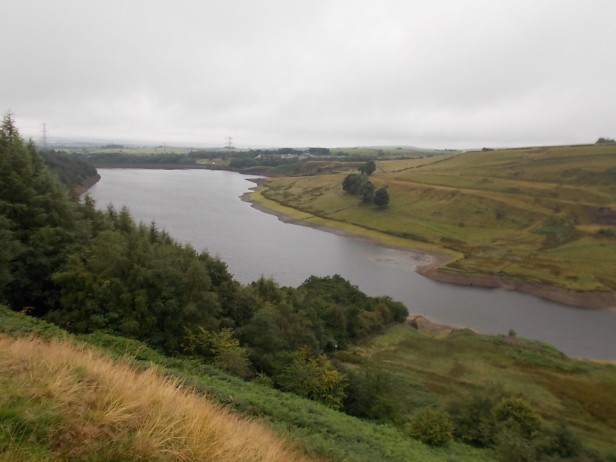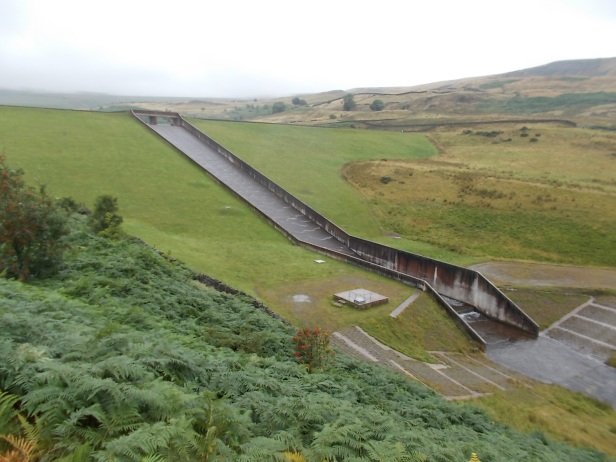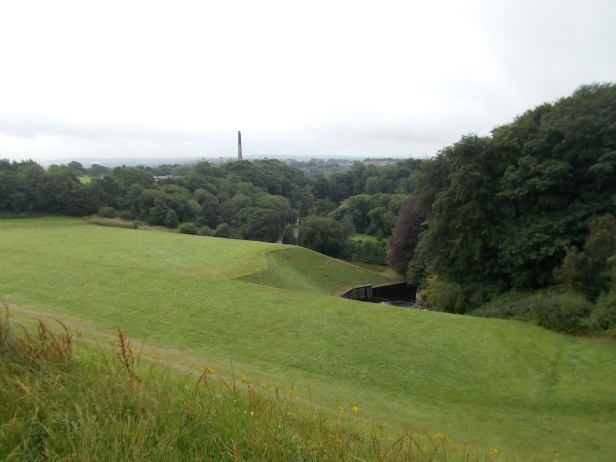Greenbooth Reservoir was the last of a string of reservoirs to be created in Naden Valley. Beneath its waters lie the remains of the village of Green Booth, which was demolished to make way for its construction. (Author’s note- the village was called Green Booth, but the reservoir, for some reason, is all one word- Greenbooth).

Green Booth village owed its existence in large part to several generations of the Butterworth family. William Butterworth owned a small wool finishing mill in the village. Here, woollen cloth would have its final preparation, undergoing special washes and rolling, before being sold as cloth. When the plans for three reservoirs within the valley were first mooted, he probably objected, worried that they would affect his water supply. The three reservoirs were completed in 1846, but by then he had other problems.

When his mill on Oldham Road in Rochdale burnt down for the second time, William relocated the whole operation to Green Booth, expanding the premises that he already had there. However, the costs of the fires and the expansion in the village led to his finances being overstretched and he was forced into bankruptcy.
James Butterworth Takes Over
His son James was a wealthy businessman in his own right. His profession was that of a wool stapler (a person who buys raw wool, sorts it and sells it on to a manufacturer). He had remained separate from his father’s mill businesses but had lent him money when his father got into financial difficulties. With his father’s mill up for sale in 1847, he took the decision to buy it. James already owned a number of farms within the Naden valley in which Green Booth sat, as well as the nearby East Knowl Colliery.
James was 62 and a widower at the time the time of the purchase. He further expanded the mill, which specialised in producing woollen flannel. The village around it also grew and he took a ‘paternalistic’ view of its inhabitants and tried to make the village as ‘self sufficient’ as possible. Rows of terraces were constructed for his workers, and detached houses for the managers. Rent and milk deliveries to their homes were deducted from their weekly wages. He provided a reading room and daily newspaper. There was a small co-operative shop for general goods, but no public houses. Half of the worker’s wages were paid in tokens that could only be spent in the village. Local farms supplied cheese, eggs and meat. Coal for both the mill and domestic use was delivered via an overhead cable system from the colliery, and the village had its own gas supply.

Every Monday, a large copper tub of hot water was set up in the mill yard. Women would come and fill their buckets using a long handled scoop, before carrying the water back home to wash clothes. The mill drying rooms were also used to dry their blankets.
In 1867, James achieved one of his great ambitions to provide a school for the local children. On the first day, it opened to admit 199 pupils, although there were spaces for up to 500. This left plenty of room for expansion and the school became a community meeting place, remaining open for 60 years.
Mary’s Rule
The following year, James died and in his will he left his daughter, Mary, in charge of the mill, school and village. Her husband Robert Hutchinson had his own factory called Novia Scotia in Blackburn, but they ran their businesses independently of each other.
Mary travelled around the village in her horse-drawn carriage. As well as her regular visits to the school, she would regularly inspect the workers’ houses. Doorsteps had to be scrubbed, and even the tables inside the homes would be checked for cleanliness.
In turn, Green Booth Mill passed to Mary’s two sons. However, in 1911, the business became bankrupt and the premises were closed. Some reports say that the sons migrated to Australia, taking some of their employees with them to set up a factory there. A further blow to the village was the school closing in 1930. Without a main employer, or a place to educate the children, the community was in serious decline. It had never been connected to the electricity grid, and looked increasingly isolated. By 1946, there were 46 houses left but 20 were derelict.

Heywood and Middleton Water Board were on the lookout for a location for a new reservoir, to meet the demand for drinking water. In 1952, they were doing surveys of the area and Green Booth appeared to be the ideal location, making it the fourth, and final, reservoir in the Naden Valley. However, this would mean relocating the residents and demolishing the remaining buildings. The announcement was made three years later.
The Rochdale Online website features residents’ reminiscences and photographs of Green Booth. A number of villagers recall the sweet shop that was just in the front room of a house. It featured a large flat stone in front of the window, so small children could stand on it to see inside and marvel at what was on offer. Children would help with haymaking in the summer time, for which they were paid half a crown. Families would walk up nearby Knowl Hill at the weekend. To read more and to see the pictures, click here
Building the Reservoir
The McAlpine Construction Company began work on the new reservoir in 1958. Trees from the surrounding woodland were felled, and huge amounts of earth excavated. Stone was brought from a Ramsbottom quarry to make the large dam. Thirty-six specialist stone masons were employed from Northern Ireland to shape the stone. Canadian timber was brought in to create props for a tunnel. This would carry the main outlet and overflow pipes leading to Clay Lane Reservoir filter house, where the water would be purified for drinking. The foundations of the reservoir were concrete, but it had a central clay core of puddled clay, which the workmen trampled into place. The reservoir dam also had a puddled clay core, one of the last in the country to be so constructed. In 1961, it started to fill and a month later it had reached half of its capacity. The total amount of water it can hold is 700 million gallons.

Dam Trouble
In 1983, a member of the public walking his dogs noticed a depression in the asphalt on top of the Greenbooth Dam. Although initially it was not large, measuring some 10 feet by 3 feet, he decided to alert the water authorities. They were immediately concerned that this could indicate that the dam was no longer watertight. Failure of the 1000-foot long dam would lead to serious consequences. The depression deepened quickly, and the reservoir water level dropped some 30 feet in eight days.
Investigation showed that the puddled clay core of the dam had developed holes. Remedial action involved plugging the voids with a mixture of bentonite cement, fly ash and clay grout. The incident was serious enough to be covered in a range of publications that discussed actual and potential dam failures. One commentator, writing in 2011, noted that a more efficient system of monitoring needed to be put in place for all reservoirs, as remote sensing did not substitute for a pair of eyes on the ground. The author of the report went on to note that the Victorian practice of having a reservoir supervisor at every site, often housed at the dam, was a wise one. He further remarked that the modern day water industry should not be having to rely on the keen powers of observation of local dog walkers.

Today Greenbooth and the Naden Reservoirs are a scenic place to walk, enjoyed by ramblers and bird watchers alike. There is a circular walk around the reservoirs, with footpaths leading up onto the surrounding moorland as well. See the access details below on where to park.
Site visited by A. Bowden and A. Shepherd 2021
Access
There are two places to park to get onto the circular walk around the Greenbooth and Naden Reservoirs.
Forsyth Lane, off Woodhouse Lane, has a free car park. The walk would start at the upper end of Greenbooth Reservoir and Naden Lower Reservoir.
Alternatively, there is parking on the road that leads to the new estate on Field View Lane (just before the new houses). The walk would start at the Greenbooth Dam.
Nearby
References
Greenbooth: The First Generation, Val Corns, Norden and District Local History Society
Lessons from historical dam Incidents, Defra and Environment Agency (2011). Available as a pdf document online
heywoodhistory.com/2012/10/the-lost-world-of-green-booth.html
abandonedcommunities.co.uk/rochdale5.html
rochdaleonline.co.uk/sites/greenbooth-memories/gallery
pressreader.com/uk/middleton-guardian/20150820/281883002081972
maps.nls.uk/view/102344003
shipspottersteve.com/blog/greenbooth-naden-reservoirs
manchestereveningnews.co.uk/news/greater-manchester-news/lost-greater-manchester-village-thats-21041680
wikipedia Norden reservoir
woolmark.com/industry/use-wool/wool-processing/woollen-finishing/
Comments are closed.